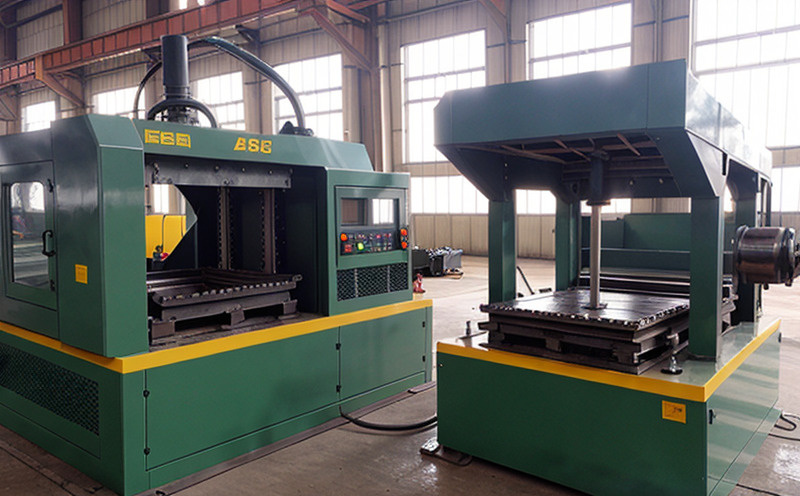ISO 6892 Tensile Testing of Forged and Stamped Metals
The International Standard ISO 6892 is a widely recognized document that specifies requirements for tensile testing of metallic materials. This service focuses specifically on the application of this standard to forged and stamped metals, which are critical components in industrial manufacturing processes.
In forging and stamping, metals undergo intense mechanical deformation to achieve specific shapes or properties. The quality assurance of these processes is paramount, as even minor flaws can lead to catastrophic failures in end products. Tensile testing helps ensure that the materials used meet stringent requirements for strength, ductility, and elongation.
Forged and stamped metals are used extensively across various sectors including automotive, aerospace, construction, and manufacturing. For example, forging is commonly used for producing engine blocks, connecting rods, and gears in automobiles. Stamping processes create parts like safety harnesses and structural components in aircraft.
The tensile testing procedure involves subjecting a sample of the material to progressively increasing tension until it fractures. This process allows engineers to determine key mechanical properties such as yield strength, ultimate tensile strength (UTS), and elongation at break. These measurements are critical for ensuring that the materials perform reliably under expected operational conditions.
In forging and stamping processes, materials undergo significant strain rates which can affect their mechanical properties. Therefore, it is essential to conduct tests that mimic these real-world conditions as closely as possible. The ISO 6892 standard provides standardized procedures to achieve this, ensuring consistency across different laboratories and jurisdictions.
The testing process typically involves the following steps:
- Selection of appropriate specimen dimensions according to ISO 6892 specifications
- Preparation of specimens by machining or grinding if necessary
- Calibration of tensile testing machines using NIST-traceable standards
- Application of load at a controlled rate until fracture occurs
- Data collection including force, extension, and time
The results from these tests are essential for quality assurance departments to make informed decisions about the suitability of materials for specific applications. By adhering strictly to ISO 6892 standards, manufacturers can ensure compliance with international regulations while maintaining high-quality standards.
Understanding the nuances of tensile testing is crucial for ensuring accurate results. Factors such as specimen geometry, loading rate, and environmental conditions all play significant roles in determining the outcome of a test. Therefore, it is important to follow best practices outlined in ISO 6892 meticulously.
In conclusion, ISO 6892 tensile testing plays an indispensable role in quality control for forged and stamped metals used in industrial manufacturing processes. By adhering to this standard, manufacturers can produce reliable products that meet strict safety and performance criteria.
Applied Standards
The primary standard applied in this service is ISO 6892: Metallic materials – Tension testing of metallic materials. This international standard provides comprehensive guidance on the mechanical tensile testing of metals, including forged and stamped parts. It covers everything from specimen preparation to data analysis.
ISO 6892 applies not only to forged and stamped metals but also to extruded, cast, and welded materials. Its scope includes both small specimens used for research and development purposes and larger ones intended for production testing. Forged and stamped parts often require specialized equipment capable of handling these larger samples without distortion.
When interpreting the results from tensile tests conducted according to ISO 6892, it is important to consider several factors:
- The type of forging or stamping process employed
- The specific alloy used in manufacturing
- Any post-treatment processes applied (e.g., heat treatment)
Understanding these variables helps laboratories provide accurate and reliable test results. Compliance with ISO 6892 ensures consistent testing methods across different facilities, enhancing comparability of data.
Scope and Methodology
| Test Parameter | Description |
|---|---|
| Tensile Strength (Rm) | The maximum nominal stress sustained by a material in tensile testing. It is measured in MPa. |
| Yield Strength (Rp0.2, Rp0.5, Rr0.2, etc.) | The lowest stress at which permanent deformation begins to occur. |
| Elongation (%) | Percentage increase in length after fracture relative to original gauge length. |
| Reduction of Area (%) | The percentage reduction in cross-sectional area from the original to that at fracture. |
| Loading Rate | The rate at which load is applied during testing, typically measured in MPa/s. |
| Specimen Dimensions | Specific dimensions prescribed by ISO 6892 for different types of materials and applications. |
| Environmental Conditions | Influences on test results such as temperature, humidity, and air pressure must be controlled during testing. |
The methodology outlined in ISO 6892 ensures consistency across laboratories conducting tensile tests. This includes precise control over loading rates, specimen dimensions, and environmental conditions. Compliance with these guidelines guarantees accurate measurement of key mechanical properties like tensile strength, yield strength, and elongation.
For forged and stamped metals, the specific procedures may vary slightly due to their larger sizes compared to smaller specimens typically used in research labs. However, adherence to ISO 6892 remains crucial for producing reliable test results.
Benefits
The implementation of ISO 6892 tensile testing offers numerous benefits to industrial manufacturers:
- Informed Decision-Making: Reliable mechanical property data enables informed decision-making regarding material selection and process optimization.
- Quality Assurance: Consistent adherence to international standards ensures product quality and safety.
- Regulatory Compliance: Meeting ISO 6892 requirements satisfies regulatory bodies' expectations, facilitating smoother business operations.
- Reduced Costs: Early detection of material defects reduces rework and scrap costs.
- Enhanced Reputation: Demonstrating commitment to quality enhances customer trust and loyalty.
- Global Market Access: Compliance with international standards opens doors to global markets, particularly for exporters.
In summary, ISO 6892 tensile testing is a vital tool in ensuring the reliability and safety of forged and stamped metal components. By leveraging this standard, manufacturers can achieve higher levels of quality assurance while maintaining competitive edge in the market.





